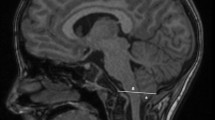Abstract
Background
We hypothesized that by using coronal MRI, Chiari I malformation could be more precisely diagnosed, would provide simple anatomic landmarks, would provide information regarding asymmetry of hindbrain herniation, and would be a better method for analyzing the tonsillar herniation postoperatively when the opisthion has been removed.
Methods
Fifty consecutive pediatric patients diagnosed with Chiari I malformation had comparison between the measurements of their caudally descended cerebellar tonsils on midsagittal and coronal MRI images.
Results
On MRI coronal imaging, tonsillar asymmetry was found in 48 patients. Maximal left tonsillar descent was 20.9 mm, and maximal right tonsillar descent was 17.4 mm. On MRI sagittal imaging, tonsillar descent ranged from 5 to 27.4 mm. Fifty-eight % of patients had syringomyelia. Five patients (10 %) on coronal MRI were found to have both cerebellar tonsils that were less than 3 mm below the foramen magnum. However, all of these patients had greater than 3 mm of tonsillar ectopia on sagittal imaging. Nineteen patients (38 %) on coronal MRI were found to have one of the cerebellar tonsils that were less than 3 mm below the foramen magnum. Similarly, each of these had greater than 3 mm of tonsillar ecotpia as measured on midsagittal MRI. Also, based on these findings, Chiari I malformation is almost always an asymmetrical tonsillar ectopia.
Conclusions
Sagittal MRI overestimates the degree of tonsillar ectopia in patients with Chiari I malformation. Misdiagnosis may occur if sagittal imaging alone is used. The cerebellar tonsils are paramedian structures, and this should be kept in mind when interpreting midline sagittal MRI.






Similar content being viewed by others
References
Chiari H (1891) Über Veränderungen des Kleinhirns in Folge von Hydrocephalie des Großhirns. Dtsch Med Wschr 17:1172–1175
Bejjani GK (2001) Definition of the adult Chiari malformation: a brief historical overview. Neurosurg Focus 11:E1
Tubbs RS, Wellons JC, Oakes WJ (2002) Asymmetry of tonsillar ectopia in Chiari malformation. Pediatr Neurosurg 37:199–202
Tubbs RS, Griessenauer CJ, Hendrix P, Oakes P, Loukas M, Chern JJ, Rozzelle CJ, Oakes WJ (2015) Relationship between pharyngitis and peri-odontoid pannus: a new etiology for some Chiari I malformations? Clin Anat 28:602–607, 2015
Cesmebasi A, Loukas M, Hogan E, Kralovic S, Tubbs RS, Cohen-Gadol AA (2016) The Chiari malformations: a review with emphasis on anatomical traits. Clin Anat 28:184–194
Aboulezz AO, Sartor K, Geyer CA (1985) Position of cerebellar tonsils in the normal population and in patients with Chiari malformation: a quantitative approach with MR imaging. J Comput Assist Tomogr 9:1033–1036
Barkovich AJ, Wippold FJ, Sherman JL et al (1986) Significance of cerebellar tonsillar position on MR. AJNR Am J Neuroradiol 7:795–799
Elster AD, Chen MY (1992) Chiari I malformations: clinical and radiologic reappraisal. Radiology 183:347–353
Meadows J, Kraut M, Guarnieri M et al (2000) Asymptomatic Chiari type I malformations identified on magnetic resonance imaging. J Neurosurg 92:920–926
Smith BW, Strahle J, Bapuraj R, Muraszko KM, Garton HJL, Maher CO (2013) Distribution of cerebellar tonsil position: implication in understanding Chiari malformation. J Neurosurg 119:812–819
Tubbs RS, Kirkpatrick CM, Rizk E, Chern JJ, Oskouian RJ, Oakes WJ (2016) Do the cerebellar tonsils move during flexion and extension of the neck in patients with Chiari I malformation? A radiological study with clinical implications. Childs Nerv Syst (in press)
Author information
Authors and Affiliations
Corresponding author
Ethics declarations
Conflicts of interest
The authors declare that they have no conflicts of interest.
Additional information
A comment to this article is available at 10.1007/s00381-016-3103-5
Rights and permissions
About this article
Cite this article
Tubbs, R.S., Yan, H., Demerdash, A. et al. Sagittal MRI often overestimates the degree of cerebellar tonsillar ectopia: a potential for misdiagnosis of the Chiari I malformation. Childs Nerv Syst 32, 1245–1248 (2016). https://doi.org/10.1007/s00381-016-3113-3
Received:
Accepted:
Published:
Issue Date:
DOI: https://doi.org/10.1007/s00381-016-3113-3




